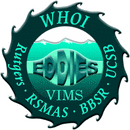|
1. Hypotheses
Prior results have documented eddy-driven
transport of nutrients into the euphotic zone and the associated
accumulation of chlorophyll. However, several key aspects of mesoscale
upwelling
events remain unresolved by the extant database, including: (1)
phytoplankton physiological response, (2) changes in community
structure, (3) impact on export out of the euphotic zone, (4) rates of
mixing between the surface mixed layer and the base of the euphotic
zone, and (5) implications
for biogeochemistry and differential cycling of carbon and associated
bioactive elements. This leads to the following hypotheses concerning
the complex, non-linear biological regulation of elemental cycling in
the ocean:
H1:
Eddy-induced upwelling, in combination with diapycnal mixing in the
upper ocean, introduces new nutrients into the euphotic zone.
H2: The increase in inorganic
nutrients stimulates a physiological response within the phytoplankton
community.
H3: Differing physiological
responses of the various species bring about a shift in community
structure.
H4: Changes in community
structure
lead to increases in export from, and changes in biogeochemical cycling
within, the upper ocean.
2. Scenarios
There are several scenarios in which this
chain of hypotheses could be linked or broken. These
include, but are not necessarily limited to, the following:
S1: Nutrient input to the
euphotic
zone simply increases the rate of production by the background species
assemblage dominated by picoplankton; impacts on biogeochemical cycling
are nil.
S2: Increased nitrate
availability stimulates
a bloom of diatoms; silica-rich organic material produced in the bloom
sinks
rapidly out of the euphotic zone once the nutrients are exhausted.
S3: Shoaling isopycnals transport
DIP closer to the surface, facilitating nitrogen fixation by Trichodesmium
or perhaps vertically migrating diatoms with symbiotic bacteria;
nitrogen-rich organic material produced during the bloom is exported
primarily in dissolved form.
S4: The eddy feature accommodates
a change in community structure and biomass of consumers that produce
rapidly sinking particles.
3. Objectives
The following objectives are designed to
test
hypotheses H1-H4 and distinguish between the
scenarios
S1-S4 in which the chain of hypotheses are linked
or
broken.
O1: Measure
the enhancement of inorganic nutrient availability brought about by
eddy-induced upwelling.
O2: Measure
the phytoplankton physiological response to increased nutrients.
O3: Assess
shifts in species composition associated with the eddy
disturbance.
O4: Quantify
the impact of the eddy disturbance on upper ocean biogeochemical
cycling: measure elemental inventories, primary production, and
export.
2004
February
Second PI meeting, ASLO/TOS Conference,
Honolulu
Summer
Field Work
2005
Winter
PI meeting: analysis of ’04 and planning
for ‘05
Summer
Field Work
2006
Winter
PI meeting: synthesis and manuscript
preparation
June
30
End date
5. Related Projects
and
Proposals
Participation
starting in 2004:
Steinberg
Zooplankton net tows
Davis
VPR
Carlson
prokaryotic community structure and DOM
dynamics
Armbrust
genetic diversity in eukaryotes
Oakey/Ledwell Finestructure
Participating
in 2005:
Shipe/Brzezinski
N and Si uptake
Fratantoni
Gliders
Schofield
Gliders
Benitez-Nelson
et al. Hawaiian Eddy Project “EFLUX”
http://www.soest.hawaii.edu/oceanography/eddy/
|
